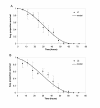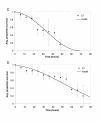Egg hatching, larval movement and larval survival of the malaria vector Anopheles gambiae in desiccating habitats
- PMID: 12919636
- PMCID: PMC183857
- DOI: 10.1186/1475-2875-2-20
Egg hatching, larval movement and larval survival of the malaria vector Anopheles gambiae in desiccating habitats
Abstract
Background: Although the effects of rainfall on the population dynamics of the malaria vector Anopheles gambiae have been studied in great detail, the effects of dry periods on its survival remain less clear.
Methods: The effects of drying conditions were simulated by creating desiccated habitats, which consisted of trays filled with damp soil. Experiments were performed in these trays to (i) test the ability of An. gambiae sensu stricto eggs to hatch on damp soil and for larvae to reach an artificial breeding site at different distances of the site of hatching and (ii) to record survival of the four larval stages of An. gambiae s.s. when placed on damp soil.
Results: Eggs of An. gambiae s.s. hatched on damp soil and emerging larvae were capable of covering a distance of up to 10 cm to reach surface water enabling further development. However, proportions of larvae reaching the site decreased rapidly with increasing distance. First, second and third-instar larvae survived on damp soil for an estimated period of 64, 65 and 69 hrs, respectively. Fourth-instar larvae survived significantly longer and we estimated that the maximum survival time was 113 hrs.
Conclusion: Short-term survival of aquatic stages of An. gambiae on wet soil may be important and adaptive when considering the transient nature of breeding sites of this species in sub-Saharan Africa. In addition, the results suggest that, for larval vector control methods to be effective, habitats should remain drained for at least 5 days to kill all larvae (e.g. in rice fields) and habitats that recently dried up should be treated as well, if larvicidal agents are applied.
Figures




References
-
- Gillies MT, DeMeillon B. The Anophelinae of Africa South of the Sahara. South African Institute for Medical Research, Johannesburg; 1968.
-
- Gill CA. The relationship between malaria and rainfall. Ind J Med Res. 1920;37:618–632.
-
- Patz JA, Strzepek K, Lele S, Hedden M, Greene S, Noden B, Hay SI, Kalkstein L, Beier JC. Predicting key malaria transmission factors, biting and entomological inoculation rates, using modelled soil moisture in Kenya. Trop Med Intl Hlth. 1998;3:818–827. doi: 10.1046/j.1365-3156.1998.00309.x. - DOI - PubMed
Publication types
MeSH terms
Substances
LinkOut - more resources
Full Text Sources
Medical

